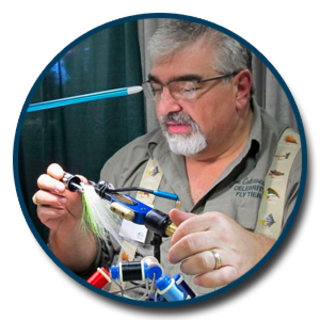Fly Tier
Biography
As a young boy, I would go to work with my father. He worked out of a tailor shop. There was an older gentleman that would sit in the corner with all kinds of pictures. He was an old WWII Navy veteran, and he was in his seventies. I never knew his first or last name. I was introduced to him as “Boats”.
I used to talk to Boats about fly fishing, fishing for bass, and going down to Florida. To me, Boats was the ultimate authority and source of guidance to everything I did not know about fishing. I was always wide-eyed talking to Boats. I listened to every word he said. I remember going by his sewing machine and there were pictures of largemouth bass, stripers, huge trout – everything. This is how my fascination with fly fishing got started.
I bought my first fly rod and reel (Ocean City) from him with the hard-earned paper route money I earned at fifteen years old. This is what got me started with fly fishing. I grew up with a fishing rod in my hand. I used to have a backpack that was full of a tackle box and supplies that I took everywhere with me. Then, after I got my driver’s license I started going to the local fly and tackle shops to look and learn about flies, tying and fishing them.
As time went on, I realized saltwater fly fishing was like a secret society. I was dealing with 8-12 ft. tides, and I tried all the Southern patterns, but they didn’t work up here. I needed to get down to the fish. Then one day, a friend of mine’s father, Ralphie Surette, gave me one of his flies. I used a WetCel straight sinking line to get the fly down to the fish. It was a bead chain style eye deceiver. And then, BANG! , I caught my first striper on a fly rod. Eventually, I moved on to lead eyes after visiting Bill Hunter at Hunter’s Angling Supplies in New Boston, New Hampshire.
Around the same time, I went over to Surf Land Bait and Tackle in Plum Island, Newburyport, Massachusetts. That day, I caught thirty Stripers all schoolies off the shore. I spoke with the owner, Kay Molton and she looked at my flies and asked, “How many can you tie for me?” That is when my commercial fly tying started. The flies that I showed her I called clouceivers, which is my version of a half and half. Back in the late 1980s I was calling it a clouceiver before I even knew what a half and half was. You can find this pattern in Deke Meyer’s book, Saltwater Flies Over 700 of the Best.
Eventually, I was tying exclusively for Dave Beshara, owner of American Angling Supplies of Salem, New Hampshire. He helped me refine my commercial fly-tying skills. Over time, I was noted for the most durable and productive flies in the area.
Ultimately, I love fishing saltwater the most. Tying saltwater fly patterns is an open field. You don’t have to go by the rules. Whatever works, you tie. In the past, there weren’t many patterns for fishing north of Boston, so that is when I decided to create my own patterns. Striper Dragons, Bonita Bear, MoJo Squids to name a few. I am also a Fly Designer for Pacific Fly Group and I can say a lot of my patterns are fished all over the world!
I am a huge natural material guy, saddle hackles, deer tails, polar bear, yak hair, are my prime ingredients. I use very little synthetics. Given, they still have their place. For instance, I love tying my epoxy minnow flies (Surf Candies style flies), they are made with Angel hair or Ultra hair. First I used epoxy, then I have switch over to UV resins (Solarez by far the best) and it makes a big difference. It works extremely well for your smallest species of tuna such as false albacore, black fin tuna, Bonita, Spanish mackerel, and creole mackerel.
My best advice for anyone looking to get started with flying tying is to use the “kiss method” of tying - Keep It Simple, Stupid. A little bit of saddle hackle and a little bit of bucktail will catch any species on planet Earth!
This is why I love the Regal Revolution Vise - squeeze the clamp put the hook in, no levers, springs and no fuss!! Ask me to tie a Clouser on the revolution and watch the vise smoke!
